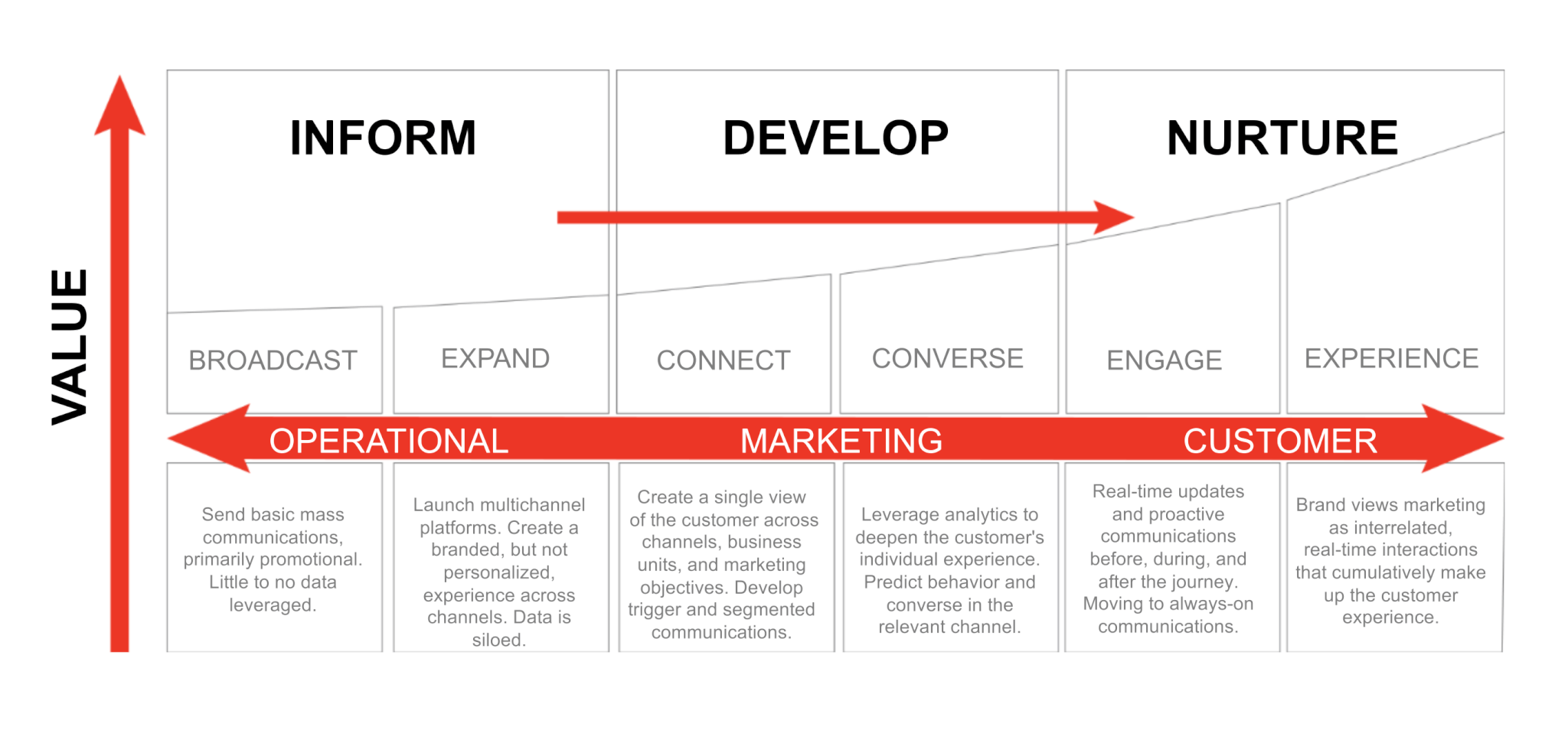Choosing the right marketing technology (martech) solution is one of the most important decisions a marketer has to make — and also the most nerve-racking. In recent years, the industry has exploded, with vendors encroaching on each other’s turf, jumping on the latest buzzwords and trends, and even creating new categories.
You know you need technology to create personalized, relevant, engaging customer experiences that drive revenue and loyalty. But how are you supposed to sort through the nearly 7,000 options? It’s not easy, but we have identified a few best practices to help conquer your decision paralysis.
No. 1: Evaluate where you are and where you want to be.
Before you can begin making martech decisions, you must evaluate where the brand is on what we call the marketing maturity continuum (above). By pinpointing the brand’s current state, marketers and stakeholders can design a road map to reach the desired future state. The brand’s position on the marketing maturity continuum helps inform the types of data, tools, and platforms necessary to achieve the vision.
Here are the basic categories on the continuum:
- Broadcast: The brand sends basic communications to customers, often a singular promotional message, broadcast in a batch-and-blast method via simple, executional technology. In this state, data is rarely used, if at all.
- Expand: Still using executional technology, the brand adds additional communications channels in an effort to reach more customers. Messaging is consistent across channels but managed manually. Data remains siloed within platforms.
- Connect: Data becomes more important as brands attempt to form a singular view of the customer. This leads to more intelligent prospecting and triggered communications. Technology is largely dependent upon data quality and customer data integration or master data management efforts at the database level. Executional platforms may still be siloed, although there is some cross functionality to ensure proper tracking and feedback loops.
- Converse: Brands leverage analytics to deepen the customer experience. Data appends and statistical models lead to increased intelligence. By predicting behavior, brands send more relevant communications and converse with customers where they’re most active. Content gets tailored by customer segments or attributes, with increased dynamic communication capabilities and platforms.
- Engage: Here the brand engages in a two-way dialogue with customers. Strong data platforms with integrated sources and complete response loops linking anonymous and known consumers are at play, along with progressive technology that’s nimble and responsive. Always-on communications are prioritized over planned campaigns.
- Experience: Often thought of as the holy grail on the continuum, this is when consumers experience brands in real-time with mutual value exchange. Technology platforms are sophisticated and often farther reaching than marketing departments can control themselves, which adds a layer of complexity.
Moving along the continuum takes money and effort, prompting brands to determine what they’re willing to invest and the point of diminishing returns, i.e., how much is enough. Not every brand needs to aspire to the Experience state.
No. 2: Embrace the journey and choose your route wisely.
Once you’ve identified the brand’s position on the marketing maturity continuum, you can see how far away the business goals are. The next step is to start planning and evaluating martech solutions — those you already have as well as those available in the marketplace. Work with other stakeholders to answer these questions and set priorities:
- Is our current martech stack capable of reaching the vision?
- What use cases are impossible today?
- Will a new technology solve those problems?
- Why might a new technology fail?
- What obstacles do we need to plan for?
- How will this drive customer loyalty and company revenue?
No. 3: Adhere to the guiding principles.
With your road map in place, it’s time to choose your implementation partners. To achieve the outcomes you want, you should demand these three things from any technology platform or strategic partner:
- Accessibility: Your technology stack should be open to enable secure, global data sharing at scale and velocity. Your partners should embrace data and direct ownership by the brand.
- Transparency: Your technology choices shouldn’t include black box offerings because you must be able to oversee the details. Your partners should architect solutions for your long-term ownership and control.
- Flexibility: Your solution should allow for orchestration and integration across platforms and technologies. Your partners should act as an extension of your team and offer flexible staffing options.
No. 4: Keep your eye on the prize.
Remember your end goal: to create personalized, relevant, engaging customer experiences that drive revenue and loyalty. Consumers expect brands to know them and cater to their demands. Deliver the experiences they want, and you brand will reap the business rewards.


